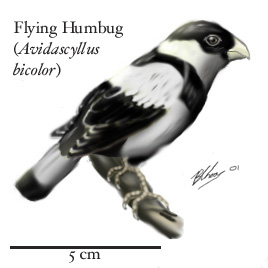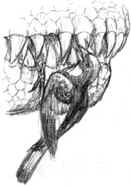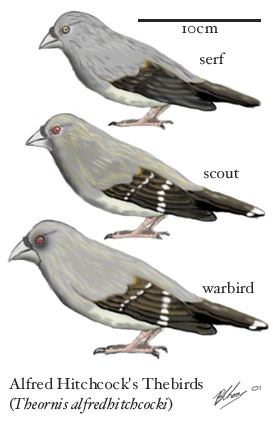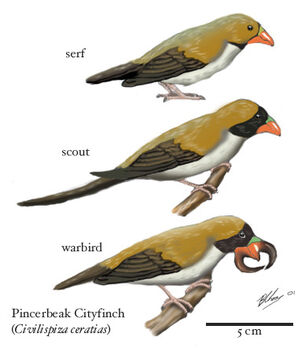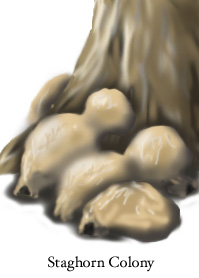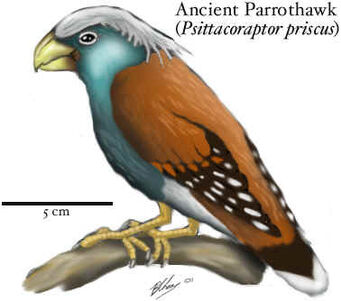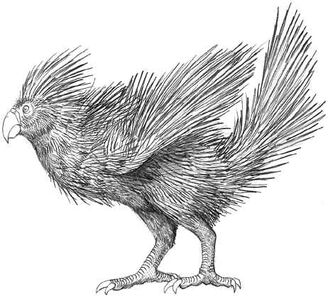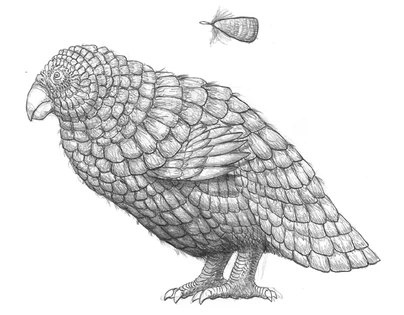Otherworld finches, cityfinches, crackers, and outlaws are the dominant small-bodied seed-eating birds of Specworld. Together with the odd parrothawks and the Specworld parrots, they comprise an estimated 2,300 species worldwide in 19 major groups. Allospiziforme anatomy shares many convergent similarities with the finches, parrots, and cuckoos of our timeline, so it is no wonder that that the true affinities of this group were long overlooked. While they were once classified as neognaths somewhere between the parrots and pigeons of Home-Earth, subsequent study has shown that the allospiziforms are not parrots, pigeons, neognaths, or indeed any kind of neornithian birds at all. Instead, the allospiziforms are part of the ancient and strange clade Enantiorniths, as evidenced by their shoulder joints and relatively slow metabolisms. Allied to the false panha and the tweetybirds, Allospiziformes probably traces its lineage back to something like the late Cretaceous Gobipteryx, an Asian enantiornith with a strong, toothless beak.
BIOLOGY[]
Otherworld finches and their kin can be found on every continent (one species makes an incredible annual migration from South America to the Antarctic island of South Georgia) and most oceanic islands. The majority of species feed on seeds, nuts and fruits, with a few insects thrown into the mix (the young, especially, eat lots of insects and spiders).
Allospiziforms are tiny to medium-sized birds with zygodactylous feet (both the first and the fourth toes point backwards). The beak is usually stout and triangular and, as in parrots, the upper beak has a hinge-like articulation with the rest of the skull, allowing it to be lifted independently to a greater degree than usual among birds. Unlike parrots, allospiziforms possess a well-developed caecum and a small cartilaginous tongue although this has changed in the parrothawks and Specworld parrots as well as having fewer neck vertebrae than normal (12 - 13).
ALLOSPIZIDAE[]
Allospizids, the Specworld or otherworld finches, are small, dumpy birds and usually posses a robust parrot-like bill for cracking seeds. The 200 or so species in this family can be found throughout Africa and the entire Northern Hemisphere south of the Arctic. They build intricate, cup-like nests and have a melodious, chirruping song.
Flying Humbug (Avidascyllus bicolor)[]
When searching for fresh food supplies, vast nomadic clouds of these tiny allospiziforms darken the skies over the African plains. When threatened by aerial predators on the wing they form a dense, globular structure. Flying humbugs generally feed on tall, seeding grasses as well as flying insects. Unlike the poisonous twitiavids that afford simple nests, otherworld finches take more drastic measures to protect their non-toxic eggs. The flying humbug in particular builds a complex nest with many “mini nests” on top, with a central chamber where the eggs are generally safe.
Painted Pfiffle (Falleravis splendens)[]
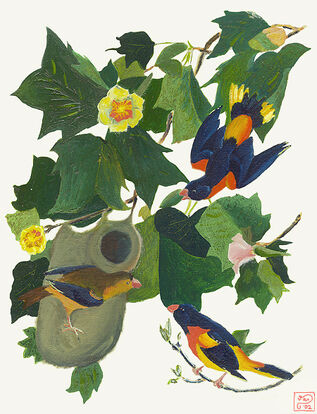
Two adult males and an adult female painted pfiffle, Falleravis splendens, around a nest on a tulip tree, p-Liriodendron paratulipifera (Eastern North America)
The painted pfiffle is one of the most beautiful allospizian species to dwell in North America. Males sport vivid black, orange, and red plumage to attract mates, and are easily recognized from a distance. Subadult and adult painted pfiffles feed exclusively on large seeds, which they crack open with their powerful bills; juveniles prefer small seeds and insects.
Like all pfiffles, this species is migratory, flying to and from its winter feeding grounds in South America every year to nest in the deciduous forests of eastern North America. Females migrate a few weeks ahead of the males, giving them time to construct or renovate their future homes. These bag-shaped nests, made of grass and sticks covered with a mud-and-saliva mixture, are nearly indestructible, and a female will come back to her nest year after year, making repairs as her abode wears out. This method of home-making is common among the allospiziforms, and is taken to extreme by the African cityfinches (see below). Unlike their distant cousins, however, pfiffles do not enlarge their nests past their original size, and a nest is usually abandoned after its maker dies.
African Toothpick (Dentistavis impavida)[]
The African toothpick lives in symbiosis with the priscataurs. The giant theropods have completely lost their forelimbs, and as a result have no way of cleaning the flesh and assorted material that gets stuck between their teeth and in their numerous cranial horns when they feed. Instead, after feeding, they attract toothpicks by extra-scary, deep bellows and let the birds swarm around their mouths, picking up whatever scraps they can find, and often also cleaning the dinosaur of parasites (such as the dinomite, Sauracarus philopriscataurus, which can often be found in the ears of priscataurs). This also distracts the birds from open wounds, as they otherwise drink blood from animals they land on.
The other three toothpick species are for the most part insectivores, but also have a tendency to eat tetrapod meat, either scavenging or attacking other animals like small mammals, bashing their skulls with rocks while they’re asleep in order to eat their brains. All toothpicks are nest parasites, laying their eggs in the nests of other avians, favoring other opposite-birds due to their relatively relaxed acceptance of other eggs, as enant parents aren’t as pressured as “true” bird parents in terms of wasting energy in raising the chicks that will hatch. Other birds also accept toothpick eggs, however, as their at-best-distasteful poisonous eggs discourage nest raiders.
CIVILISPIZIDAE[]
The most remarkable of the allospizians, the cityfinches are the closest either of our universes has come to creating eusocial birds on par with ants and bees. The family contains about 50 species and is restricted to Africa and Madagascar. Cityfinches eat primarily grass seeds and other grains, and most species dwell in permanent colonies or cities, many rivaling human settlements in their population density and relative size. Most cityfinch species dwell in permanent colonies or cities. Many forms exhibit extreme sexual dimorphism, the result of the different sexes performing differing functions in cityfinch society.
Alfred’s Hitchcocks (Theornis alfredhitchcocki)[]
The most primitive of the cityfinches, Alfred's hitchcocks display a less pronounced degree of dimorphism between the two sexes. However, this species creates the largest cities and displays the highest degree of aggression in their defense.
A hitchcock city begins as a globular structure with a single entryway built of mud, twigs, droppings, and saliva in the branches of a tree in the savanna. As the colony grows, additional chambers and entrances are built and the city soon fills most of the lower branches and eventually extending down the trunk towards the ground. Fully-grown cities completely obscure the shape of their long-dead host-tree and resemble great clay skyscrapers growing out of the ground. Such a colony may be over 2 centuries old and may contain over a thousand birds.
Each large city is a maze of tunnels, nest chambers, nurseries, and storage facilities. Some chambers act as gardens where the birds harvest fungi grown from refuse. Actively utilized chambers are generally restricted to the outer 2 meters of the colony.
The fanaticism with which hitchocks defend their cities is nothing short of terrifying. Unlike other species, scouts and serfs will also engage enemies in combat. Normally intruders are seen off with swooping displays. However, the high-pitched distress calls emitted by injured or dying birds seem to send the entire colony into a state of bloodlust, with birds murderously attacking any non-hitchcock within a 100-meter radius of the colony. The warbirds secrete a toxin in their saliva which produces painful sores on the skin when pecked.
If provoked by a large animal, the birds swarm upon the unfortunate beast in a frenzied, uncoordinated attack with little regard for their individual safety. There is one documented case of an old, crippled horned molok, it was eventually revealed that it was wounded by a sahel elumbe hours earlier, which stumbled into a large hitchock city, caving in one side of the colony and immediately incurring a warbird attack. Panicked and confused, the theropod blundered into the colony again, tripped, fell, and was immediately consumed in a cloud of furious birds, its agonized cries audible above the din of screeches.
The attack petered out in about 20 minutes and the molok's carcass was examined while keeping a watchful eye (and flamethrower) on the blood-drenched warbirds which glared down at the researchers while serfs began to repair the damaged colony. Both the theropod's eyes had been pecked out and its orbits were filled with dead hitchocks as were its nostrils, ears, and colon.
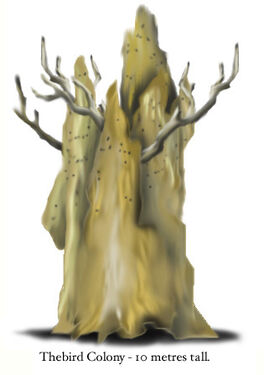
Colony of Alfred’s hitchcocks, Theornis alfredhitchcocki, around a dead blue-green manglar, Neocheirolepis cyanochloris (East Africa)
Pincerbeak Cityfinch (Civilispiza ceratias)[]
A common cityfinch species in woodlands and open forest throughout southern Africa, the pincerbeak (Civilispiza ceratias) lives in colonies of 20 to 60 birds. The colonial structure is built in the branches of a tree or shrub and consists of a series of interconnected open cup/bowl-shaped mud structures covered in "roofs" of thatching.
The sharp extensions on the warbirds' beak are formidable weapons. However, they are also used as "tongs" when moving eggs.
Mauritian Backscratcher (Civilispiza sauropurgor)[]
Though not related to the p-Coraciiforme(?) backscratcher birds of mainland Africa, both birds share the habit of following sauropods. Mauritian backscratchers build their nest high in the branches of a tree and feed on the parasites of any Mascarene mokele in the vicinity. If no sauropod is in the area, they can and will feed on any other food source. Like all cityfinches, Mauritian backscratchers and Réunion backscratchers (C. reunionensis) are fiercely territorial of their cities and will attempt to kill anything that intrudes. A few species, however, have evolved ways to invade and live in a backscratcher city. Most are armored, like the walnut beetle, a flightless omnivorous beetle whose extra-tough shell will protect it.
Comoros Staghorn-Bird (Molochavis comorensis)[]
One of the largest cityfinches, the Comoros staghorn-bird is restricted to the Comoros islands where it is one of the most common non-seabirds in residence. The species is unique in building colonies directly on the ground with subterranean chambers. Staghorn cities are built at the bases of large trees and consist of a series of domed mud/clay structures aboveground connected by a series of underground tunnels amongst the roots of the tree. Such colonies generally contain about 10 –to- 30 adult birds.
The quail-like warbirds spend most of their time on the ground, their extraordinary beaks imposing a hefty aerodynamic penalty. They are incapable of feeding themselves and must be tended to by serfs and returning scouts. Their natural enemies on the islands include large lizards, tenrecs, and predatory seabirds. When threatened, the warbirds retreat tailfirst into the entrances, leaving their formidable beaks protruding.
Shell Scooper (Crustaphaga timidus)[]
A shy, sparrow-sized allospiziform, the shell scooper occurs mainly in Mauritius' coastal wetlands and swamp forests, although they can also be found along creeks and rivers in the island's interior. Their diet consists of snails, which they spoon out of the shell with their hooked beaks. Mating and nesting take place near the end of the dry season (late October/early November), in order to raise their 2-3 young when conditions are more favorable.
PSITTACORAPTORIDAE[]
The parrothawks are heavily built allospiziforms with large, hooked beaks. Their name is a bit misleading as these birds are generalist omnivores rather than dedicated predators, feeding upon fruit, nuts, eggs and small animals. This African group contains about a dozen species, mostly restricted to tropical rainforests.
Ancient Parrothawk (Pisttacoraptor priscus)[]
So named because of its crest of "grey hairs", the ancient parrothawk lives in mangroves and dense lowland rainforest, usually amongst the lower branches and stilt/buttress roots. Its screeching cry usually gives away its position long before the bird can be seen.
This parrothawk feeds on insects and small vertebrates as well as fallen fruit.
APATOPSITTACIFORMES[]
The warmer areas all over the globe harbor many birds that look like parrots, climb like parrots, fly like parrots, and behave like parrots, but are in fact, not parrots. If it were not for the recent discovery of the parrothawks (and one genetic study only recently published), they would still be considered parrots. Indeed, only a few skeletal details (such as the famous shoulder joint) make it clear that they are not parrots but opposite birds, more precisely, allospiziforms.
Warm areas all over the globe but particularly Oceania harbor birds that, despite the weirdness of some representatives, look like parrots, climb like parrots, fly like parrots, and behave like parrots (their intelligence is even comparable). If it were not for the internal enantiornithian traits, as well as ribbon-like tail feathers, they’d easily be mistaken for psittaciformes. Some wonder if a peculiar lower jaw from the Late Cretaceous of Home-Earth’s Montana, originally identified as belonging to a parrot (a lory, to be precise) well over 40 millions of years ahead of its time, might belong to a Specworld parrot instead. In this case, Specworld parrots would have existed in both worlds before the K-T boundary. However, more recent genetic studies seem to suggest that they diverged from their relatives as recently as the early Miocene.
Long-Tailed Ground Parrot (Geobates pachyrhynchus)[]
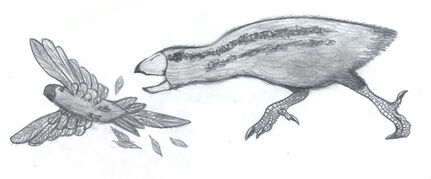
Long-tailed ground parrot, Geobates pachyrhynchus, and Lowland keetraider, Diablornis psittaphagus psittaphagus (Aotearoa, North Island)
Unlike HE ground parrots, the long-tailed ground parrot is a very conspicuous animal and lives in Aotearoa. Females bear garish red, blue and yellow feathers, with iridescent violet patches on the head and neck, and it seemingly has many other iridescent patches seen only in UV, while males are of a more mute dark brown. Foraging on the ground during the day time, the long-tailed ground parrot is even quite sonorous, emitting a series of loud, obnoxious calls. It prefers forest clearings, where females exhibit their bright feathers, defending territories that may span over 1 square mile. A very polyandrous bird, females may mate with a group of up to 10 males, which stay in her territory to incubate her eggs.
Porcuparrot (Echinopsitta longicaudata)[]
Two clades of flightless Specworld parrots are endemic to Aotearoa. But unlike the succulent and vulnerable kakapo of Home-Earth, in the presence of ground predators in the form of gobblers and fells, these parrots have evolved a powerfully effective defense by turning their feather quills into defensive armament. Strangely enough, the two bird taxa are not closely related, meaning that this occurred twice in the history of Spec.
The porcuparrot has turned most of the larger feathers into long, sharp quills, especially on the wings and tail, while downy feathers underneath still provide insulation. An opportunistic omnivore in the absence of competing mammals, it feeds on a variety of morsels in the woodlands that are its home, from buds, leaves, and nuts to small animals or even carrion. The porcuparrot is still good at climbing, but obviously doesn’t compete with its volant relatives.
Pinecone Parrots (Hoplopsitta spp.)[]
Pinecone parrots range in adult size from about the HE kakapo (common pinecone parrot, Hoplopsitta vulgaris) to a small sheep (arctotitan pinecone parrot, Hoplopsitta grandis). All these birds are ground-dwelling mixed grazer/browsers, large species found mostly in open country, the smaller ones in woodland. Each of their feathers is fused into a thick, hardened scute, making the bird nearly immune to attacks from predatory birds. Wing feathers remain, but are large hollow shafts that are beaten or rasped against the feather scales to create noises used in intraspecific communication. As usual among opposite-birds, pinecone parrots have a long, lone childhood. It is therefore not uncommon to see specimens no larger than a pinecone (which were originally described as a separate species, Hoplopsitta nana) when the well-camouflaged birdies move. They have the dubious honor of being the least intelligent Specworld parrots, though it still engages in very complex social behaviors.
Palgerigar (Apatopsittaca undulatus)[]
Due to the prevalence of other allospizians, small Specworld parrots are rare. The palgerigar is one of the smallest, about the size of the Psittacula parakeets. Colored in various shades of yellow and green, the palgerigar occurs in the dry savannas of Australia, gathering in large flocks in search of food and water. An advantage it has over HE parrots is its practicality, not being constrained by needing to provide food and water to the chicks. However, as intelligent birds, they tend to have strong social bonds, and in effect, the young are basically raised by the flock, protected by older birds and learning tricks necessary for life in the desert.
Northern Sparrowkeet (Psittacispiza borealis)[]
One of the most common birds in North America, sparrowkeets travel together in huge numbers, comparable to that of HE North America's extinct passenger pigeon (Ectopistes migratorius) and Carolina parakeet (Conuropsis carolinensis), which they bear a striking resemblance to. Ranging across the western half of the continent (west of the Rockies onward), their flocks have numbered in the thousands, although actual flock number varies depending on the species, local environment, food availability, etc. At least half a dozen species have been recognized.
The northern sparrowkeet (Psittacispiza borealis) is a typical sparrowkeet, spending its summer in south-western Canada and migrating to the thick rainforests of Washington and northern Oregon for the winter. At the opposite end of the genus' range is the desert sparrowkeet (Psittacispiza mexicana).
Desert Sparrowkeet (Psittacispiza mexicana)[]
This species is constantly on the move traveling the searing badlands of the American Southwest. Like other sparrowkeets, this species' diet mainly consists of seeds and small insects. The arrival of a cloud/flock of desert sparrowkeets is a welcome feast to many desert predators. Buffalo bills have been observed running, jaws agape, through a passing flock, and coming out the other side with a mouth full of the birds.
BARORHYNCHIDAE (Crackers)[]
Crackers are compact, finch-like birds, easily confused with otherworld finches. However, crackers have a heavier, more powerful beak, and an enormous gape that opens slightly over 90°. These adaptations enable crackers to feed on the very toughest and largest seeds, and have earned them their name. Crackers are also surprisingly good singers, and their songs can be heard over much of the Northern hemisphere, Africa, and Central America.
Common Cracker (Barorhynchus personatus)[]
The common cracker is fairly representative. Found across most of Europe, this cracker uses its bill to get the better of chestnuts and walnuts, feeding also on small insects from time to time. Its call is a bubbling, happy twittering: "chirrup-tweet, chirrup-tweet" that some translate to "cheer up, sweet".
Tchaikovsky's Nut-Cracker (Barorhynchus sibiricus)[]
Tchaikovsky's nut-cracker has the most northerly range, but is just as easily found as far south as the Balkans. Its melodious call is hauntingly beautiful, gently paced and unhurried, sounding like a human chorus when several are singing together.
Hawcracker (Eubarorhynchus coccothraustes)[]
The hawcracker employs an exceptionally strong bill that can just as easily chomp through a spexplorer's finger; its song sounds naggingly like "oranges-and-lemons". Smith-birds like the hephaestos (Martelornis yunnani), the andvari (Martelornis teutonicus), and the ilmarinen (Martelornis borealis) have a chinking song, like A hammer against metal.
Pine Cracker (Pinornis enucleator)[]
The pine cracker is a common visitor to pine trees, with a twisted beak that extracts seeds from cones and subsequently crushes them. Pine-cracker songs sound more like cicada buzzing than anything else, and the longer the bird sings without taking a breath, the more powerful the song.
Tipsy-bird (Bibulornis bibulus)[]
Probably the strangest cracker is the tipsy-bird (Bibulornis bibulus), which entertains a bizarre symbiosis with the African Bacchus tree (Bachebenevenies istudvinum). Bacchus trees yearly produce a bizarre elongate drupe fruit, somewhat like an elongated, flat-bottomed pear. These fruits are produced on the highest branches, and are usually out of reach of most animals. However, the ripening process is brought about startlingly fast, and before long chemical reactions in the fruit have degraded the nutrition into powerful sugars and alcohols, and turned the fruit a bright red color. This is the cue for the tipsy-birds. Having fed on seeds and insects for most of the year, the birds make a beeline for the Bacchus tree. Soon the tree is covered by countless crackers, each neatly snipping fruit off the branches. Their beaks make short work of the rind and the seed coat, and they gorge themselves. The tree, however, has other plans. The potent alcohols of the fruit soon have their effect on the tipsy-birds, and effectively make them commit mistakes essential to the dissemination of the Bacchus tree. The birds may lose their flight path and end up traveling long distances off their mark, excreting the seeds at a convenient distance from the parent tree. They may become clumsy at cutting up the fruits, ingesting seeds with cracking them; or they may drop uneaten fruit to the ground, to be detected and eaten by yet other fruit-eaters.
The heady brew gives them digestive trouble, diarrhea, and vomiting, ensuring that the seeds are quickly lost from their avian vectors. By the end of the day, the seeds have been dispersed, and the birds rest on safe perches until they are sober. Tipsy-birds are not the only purveyors of Bacchus-tree seeds; many other animals, such as carpos, oviraptorosaurs, and other fruit-lovers have been known to take the fruit (and get drunk). Nonetheless, over most parts of the tree's range, the tipsy-birds are the fastest and the first to arrive on the scene and crowd out their competitors. Through this, the tree ensures its success. Bacchus-tree fruit has exactly the same effect on humans as it does on all other animals. It has potential economic value as an easily-accessed source of alcohol.
[]
- Brian Choo and David Marjanovic
,=Avidascyllus bicolor (Flying humbug)
,=Allospizidae=|
| `=Falleravis splendens (Painted pfiffle)
,=|
| | ,=T. alfredhitchcocki (Alfred's hitchcock)
| | ,=Theornis=|
| | | `=T.impavida (Toothpick)
| `=Civilispizidae=|
| | ,=Civilispiza ceratias (Pincerbeak cityfinch)
,=| `=|
| | `=Molochavis comoroensis (Comoros staghorn-bird)
| |
=Allospiziformes=| | ,=Psittacoraptoridae=Psittacoraptor priscus (Ancient parrothawk)
| `=|
| `=Apatopsittaciformes=Geobates pachyrhynchos (Long-tailed ground parrot)
|
`=†Gobipteryx minuta


